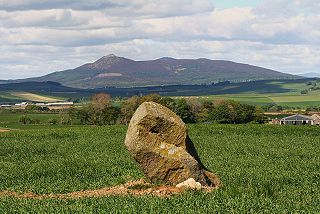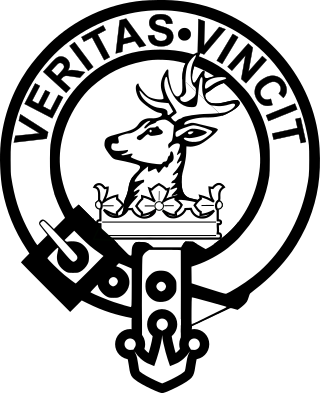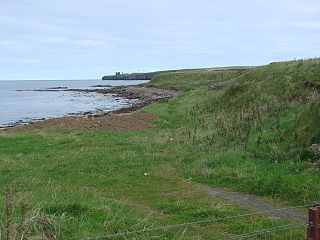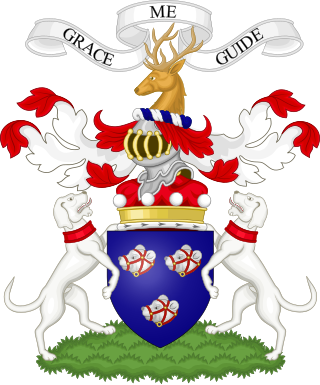
James Graham, 1st Marquess of Montrose was a Scottish nobleman, poet, soldier and later viceroy and captain general of Scotland. Montrose initially joined the Covenanters in the Wars of the Three Kingdoms, but subsequently supported King Charles I as the English Civil War developed. From 1644 to 1646, and again in 1650, he fought in the civil war in Scotland on behalf of the King. He is referred to as the Great Montrose.

The Battle of Harlaw was a Scottish clan battle fought on 24 July 1411 just north of Inverurie in Aberdeenshire. It was one of a series of battles fought during the Middle Ages between the barons of northeast Scotland against those from the west coast.

Clan Keith is a Highland and Lowland Scottish clan, whose Chief historically held the hereditary title of Marischal, then Great Marischal, then Earl Marischal of Scotland.

Clan Gordon is a Highland Scottish clan, historically one of the most powerful Scottish clans. The Gordon lands once spanned a large territory across the Highlands. Presently, Gordon is seated at Aboyne Castle, Aberdeenshire. The Chief of the clan is the Earl of Huntly, later the Marquess of Huntly.

Clan Gunn is a Highland Scottish clan associated with lands in northeastern Scotland, including Caithness, Sutherland and, arguably, the Orkney Isles. Clan Gunn is one of the oldest Scottish Clans, being descended from the Norse Jarls of Orkney and the Pictish Mormaers of Caithness.

William Keith, 7th Earl Marischal was a Scottish nobleman and Covenanter. He was the eldest son of William Keith, 6th Earl Marischal.

Fetteresso Castle is a 14th-century tower house, rebuilt in 1761 as a Scottish Gothic style Palladian manor, with clear evidence of prehistoric use of the site. It is situated immediately west of the town of Stonehaven in Kincardineshire, slightly to the west of the A90 dual carriageway. Other notable historic fortified houses or castles in this region are Dunnottar Castle, Muchalls Castle, Fiddes Castle, Cowie Castle and Monboddo House.

Castle Chanonry of Ross, also known as Seaforth Castle, was located in the town of Fortrose, to the north-east of Inverness, on the peninsula known as the Black Isle, Highland, Scotland. Nothing now remains of the castle. The castle was also known as Canonry or Chanonrie of Ross, the former county.

The Battle of Glenlivet was a Scottish clan battle fought on 3 October 1594 near Glenlivet, Moray, Scotland. It was fought between Protestant forces loyal to King James VI of Scotland who were commanded by Archibald Campbell, 7th Earl of Argyll, against Catholic forces who were commanded by George Gordon, 6th Earl of Huntly, and Francis Hay, 9th Earl of Erroll. The Catholics won a decisive victory in the battle, but in the aftermath were subdued by King James.

Clan Irvine is a Scottish clan.

Sir Robert Keith was a Scottish nobleman and a hereditary Great Marischal of Scotland.

The Castle of Rattray was a medieval Scottish castle, with multiple variations on its structure over approximately six centuries. Originally built as a "late 12th- or early 13th century defensive motte" it provided protection for Starny Keppie Harbour and Rattray village. Sometime between 1214 and 1233 it was upgraded by William Comyn, jure uxoris Earl of Buchan before being destroyed in the 1308 Harrying of Buchan. After Comyn's timber castle was burned down, it was replaced by a stronger stone castle which was engulfed during a 1720 sand storm along with nearby Rattray village. After the storm, the castle was not dug out and remains covered to this day. The castle was described by W. Douglas Simpson as one of the nine castles of the Knuckle, referring to the rocky headland of north-east Aberdeenshire.

The Battle of Tannach was a Scottish clan battle fought about 3 miles (4.8 km) southwest of Wick, in the far north of Scotland. It was fought between men of the Clan Keith and Clan Mackay from Strathnaver against men of the Clan Gunn and possibly their allies the Clan Oliphant and Clan Sutherland from Caithness. The date is uncertain, it was probably in 1464 but may have been in 1438.

The Battle of Champions was a trial by combat fought in 1478 or 1464 between two Scottish clans, Clan Gunn and Clan Keith. It took place at the chapel of St Tears on the coast north of Wick in Caithness, between Ackergill Tower and Girnigoe Castle. It was arranged to settle a dispute with a battle between twelve men on horseback on either side. However, the Keiths arrived with two men on each of their twelve horses, and massacred the 12 Gunns. The clans finally signed a treaty of friendship in 1978, ending the feud after 500 years.

Auld Bourtreebush is a large Neolithic stone circle near Portlethen in Aberdeenshire, Scotland. It is also known as Old Bourtree Bush or Old Bourtreebush. This megalithic construction is situated near the Aquhorthies recumbent stone circle and the Causey Mounth, an ancient trackway which connects the Scottish Lowlands to the highlands. It is a scheduled monument.

Clan Forbes is a Highland Scottish clan from Aberdeenshire, Scotland.

William Keith, 4th Earl Marischal was a Scottish nobleman and politician.
James Ferguson was a Scottish lawyer and was also the 1st Laird of Pitfour, a large estate in the Buchan area of north-east Scotland, which became known as 'The Blenheim of the North'. Prior to the purchase of the Pitfour estate, he had the honorific 'James Ferguson of Badifurrow', the estate he eventually inherited after his grandfather cut all ties with Ferguson's uncle, Robert Ferguson, who was in hiding to attempt to avoid treachery charges.
The Sheriff of Aberdeen was a royal official who was responsible for enforcing justice in Aberdeenshire, Scotland. Prior to 1748 most sheriffdoms were held on a hereditary basis. From that date, following the Jacobite uprising of 1745, they were replaced by salaried sheriff-deputies, qualified advocates who were members of the Scottish Bar.

Michael Canning William John Keith of Urie, 13th Earl of Kintore, styled Master of Inverurie between 1974 and 1989, was a Scottish peer and nobleman.




















